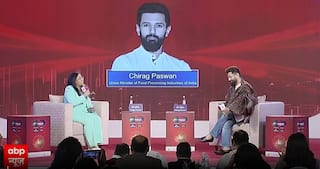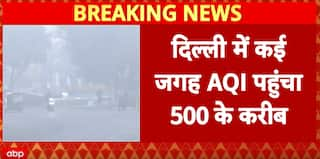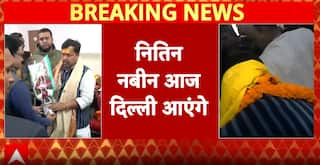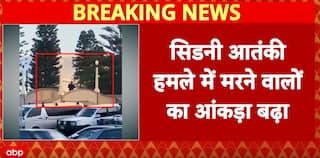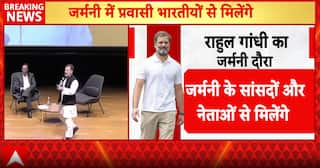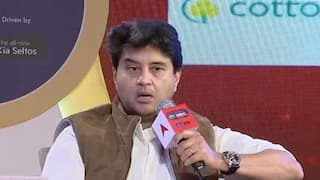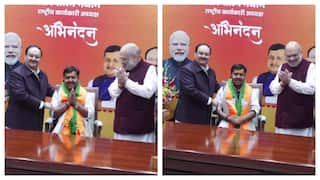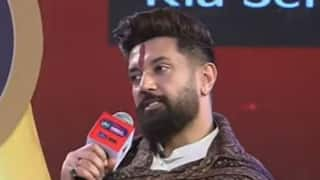Explorer
Desh Ka Mood: Modi magic continues, NDA projected to win 331 seats

The Mood of the Nation Survey has found that in the event of a Lok Sabha election taking place now, Prime Minister Modi’s party, the Bharatiya Janata Party (BJP) would secure yet another convincing victory,.
NEW DELHI: Narendra Modi clearly appears to become the next prime minister and the ruling National Democratic Alliance led by him would ascend to power with 331 seats if Lok Sabha elections were held now, a survey conducted by ABP News and Lokniti-CSDS predicted on Monday. The United Progressive Alliance is projected to win 104 seats, which is a gain of 44 seats compared to their dismal outing in 2014 polls. The Other parties in the fray are likely to get 108 seats, 40 seats lesser than what was achieved earlier. The study from 142 constituencies in the eastern states shows that there would be a gain of 16 seats for the NDA here. Major gains in Assam, West Bengal and Assam. A three seat rise for the UPA while drop of 19 seats for Other parties.
#देशकामूड Vote share and seat prediction in Eastern states - if elections were held today. NDA - 71 (16+), UPA - 25 (+3), Others - 46 (-19) pic.twitter.com/ustkyH0Eko
— ABP News (@abpnewstv) May 22, 2017
#देशकामूड NDA to gain 16 seats in East CSDS survey @abpnewstv if Lok Sabha polls were to be held today. Gains from Bengal, Odisha & Assam — milind khandekar (@milindkhandekar) May 22, 2017In the crucial North Indian states (151 constituencies), the survey predicts a loss of 15 seats for the NDA which takes its tally to 116 seats. UPA which is likely to gain 9 seats in the region is projected to win mere 15 seats in total. Other parties get 20 here, a gain of 6 seats.
#देशकामूड Vote share and seat prediction in North Indian states. (Graphics below) pic.twitter.com/e7OkNzTZdw
— ABP News (@abpnewstv) May 22, 2017
#देशकामूड NDA likely to lose 15 seats in North @abpnewstv CSDS poll but way ahead of UPA with 50% votes — milind khandekar (@milindkhandekar) May 22, 2017
In Southern India’s 132 constituencies, there is a gain for the UPA with 29 seats taking its tally to 52. Thirty nine in totality for the NDA and forty six seats for the regional parties.#देशकामूड NDA likely to lose seats in Rajasthan, UP , Punjab & Haryana in North if Loksabha polls were held today @abpnewstv CSDS survey
— milind khandekar (@milindkhandekar) May 22, 2017
#देशकामूड Vote share and seat prediction in Southern India - if polls were held today. NDA- 39 (-1), UPA - 52 (+29), Others- 41(-28) pic.twitter.com/OqfLBQkIlt — ABP News (@abpnewstv) May 22, 2017In Western and Central India, the NDA is set to take the lion’s share with 105 out of 118 seats. Survey shows UPA winning 12 seats in these regions.
#देशकामूड Vote share and seat prediction in West and Central India - if polls were held today. NDA- 105 (-4), UPA - 12 (+3), Others- 1(+1) pic.twitter.com/qOhgTbZviB
— ABP News (@abpnewstv) May 22, 2017
#देशकामूड Modi Magic continues in Western & Central India, NDA to win 105 out of 118 seats @abpnewstv CSDS poll if Loksabha poll held now — milind khandekar (@milindkhandekar) May 22, 2017The nationwide Survey (Mood of the Nation) among 11,373 randomly sampled voters in 19 States has found that nearly seven in every ten voters (69 percent) are satisfied with the performance of Narendra Modi as prime minister. This satisfaction rating is higher than the satisfaction ratings recorded for Modi’s predecessor Manmohan Singh at the end of the first two years of the UPA I and II governments. More significantly, the Mood of the Nation Survey has found that in the event of a Lok Sabha election taking place now, Prime Minister Modi’s party, the Bharatiya Janata Party (BJP) would secure yet another convincing victory, quite similar to the one it notched up in 2014. The Survey found the BJP to be the vote choice of 39 percent or close to four of every ten voters. This is eight percentage points greater than the vote share secured by the party in the Lok Sabha elections held three years ago. The BJP’s allies are expected to get 6 percent votes taking the ruling alliance’s vote share to about 45 percent. This significant vote increase, however, may not translate into too many additional seats for the BJP as most of its major vote gains are in those States where it had already scaled the peak in terms of seats in 2014. In fact, it may actually lose a few seats in these stronghold States as the vote share of the opposition parties is highly concentrated. The Indian National Congress (Congress) which slumped to its worst ever electoral performance in a national election in 2014 continues to be in dire straits in terms of popularity and is finding it difficult to revive. If elections to the Lok Sabha were to happen today, the party that governed India for 55 years is expected to secure only 21 percent votes, an increase of just two percentage points since its disastrous performance in 2014. Congress’s allies seem to be in no great shape either with only 6 percent of the voters indicating their vote preference for them. Except for Punjab and Telangana, the Survey did not find any other state where the BJP’s popularity has lessened compared to elections held three years ago. In some States, the BJP is so far ahead in the race at the moment that even a coming together of two or three opposition parties may not fully bridge the gap. Not only has the BJP consolidated and extended its appeal in northern, central and western India where its main competitor is mostly the Congress, it has also made some stunning gains in the eastern part of the country where regional parties dominate. In Odisha, for instance, the Survey found the BJP to be leading the Biju Janata Dal that has been ruling the State for nearly two decades. In West Bengal, meanwhile, it was found to be placed a fairly close second behind the Trinamool Congress. If in 2014, most of BJP’s victories came at the expense of the Congress, the next election in 2019 could well see the BJP posing a serious threat to the dominance of India’s regional parties as well. The BJP’s growing dominance in Indian politics is mostly on account of PM Modi’s tremendous popularity among the masses. Three years into office, Modi has cemented his position as the tallest leader in contemporary India. From being a relatively low profile leader in national politics less than a decade back to being India's most popular leader today, Modi’s career graph has been no less than phenomenal. Time series data on the prime ministerial preference of Indian voters reveals that Modi, from the being the spontaneous choice of a mere 2 percent of the electorate in 2009 is now the preferred prime ministerial choice of a whopping 44 percent of India’s voters. This is also eight points higher than the proportion of those who wanted to see him as India’s Prime Minister during the 2014 election. None of Modi’s opponents come anywhere close to him, their popularity being limited to single digits. The survey found the Prime Minister’s nearest rival, Congress Vice-President Rahul Gandhi to be a huge 35 percentage points behind him. Only 9 percent respondents expressed a spontaneous preference for Gandhi as prime minister. This is a decline of 4 percentage points since the last election. What’s more, when voters were asked who they thought should lead the Congress into the next election only one in every four (25 percent) took Rahul Gandhi’s name. Among Congress voters too, the preference for Rahul was quite low at just 39 percent. Modi’s pan India appeal is further buttressed by his popularity across big cities, small towns and villages, across regional divisions and gender. What is particularly striking is the astonishing pace at which the Modi wave is sweeping India’s small cities and towns, with an overwhelming 47 percent of small town voters desirous of seeing him at the helm. This is almost 11 percentage points up from 2014. The Survey found Modi’s popularity having increased across all regions of the country with the increase being greatest in eastern India. Findings also show that even though Modi continues to be preferred more by men than women, he has greatly endeared himself to women voters in the last three years. 41 percent of women in the Survey expressed a preference for him, up from a mere 30 percent in 2014. This increase of eleven points is greater than the one seen among men. Interestingly, the Prime Minister also appears to be gaining greater acceptance among India’s religious minorities, which have hitherto viewed him with eyes of suspicion. 18 percent or almost two in every five Muslims said they would like to see Modi return as the PM in the event of a snap election now. Back in 2014, this figure had been a modest 9 percent or one in every ten. Among Christians too his popularity has doubled from 16 percent to 32 percent. The survey also found both these communities, Muslims and Christians, to be supporting the BJP in much greater proportions than they did in 2014. Support for the BJP among Muslims has gone up from 8 percent to 15 percent. Among Christians it has climbed from 7 percent to 19 percent. Meanwhile, Hindus, not surprisingly, are most attracted to the BJP with 44 percent of them indicating that they would vote for the party in the event of a national election now. This is eight points higher than their support to the BJP in the 2014 election. Among Hindus however, Dalits continue to be the least likely to support the BJP (32 percent), however support for the BJP among them has also registered a sharp increase of eight percentage points. Demonetization Contrary to perceptions in some sections of society, PM Modi’s move to demonetize old 500 and 1000 rupee notes (which accounts for about 86 percent of the total currency in circulation) appears have been a resounding success, in so far as its politico-electoral implications are concerned. The Survey finds that nearly half the voters (45 percent) believed that it was the right move compared to only 16 percent respondents who thought the move was unnecessary and wasn’t required at all. Meanwhile, about one in every three (32 percent) were of the opinion that while the decision to demonetize was right it was done in a hurry without any groundwork. It must be stressed here that even as the survey finds fairly high support for Modi’s demonetization decision, it is certainly nowhere close to the kind of overwhelming support that was claimed by the Prime Minister’s own app-based survey conducted back in November. The Mood of the Nation survey found that while there is support for demonetization across classes, poor voters, especially the urban poor, have been the least enthused by it. More than one fourth (26 percent) of the poor living in the India’s big cities thought that the move was completely unnecessary, a finding which contests Modi government’s unqualified claims about demonetization being a pro-poor move that had the full backing of the poor. Intriguingly though, this has not diminished Modi’s appeal among India’s poor. In fact the poor have come out more strongly in support of his party, despite having endured the tribulations of demonetization. The survey found that even as the poor and lower classes continue to be less likely to vote for the BJP compared to the middle and upper classes, the gains made by the BJP among them since 2014 are greater than the gains the party has made among the higher income groups. One of the stated objectives of demonetization was to speed up India’s transition to a digital and cashless economy. To achieve this objective, the government popularized the use of credit/ debit cards and mobile wallets on an unprecedented scale. However, a cursory glance at India’s digital reality reveals that it probably did not do its homework before executing the move. The Survey finds that almost half of India’s households (49 percent) today still do not have a credit/debit card. Even those that do have a debit/credit card, almost 5 in 10 (45 percent) never use it or use it very rarely. While a vast majority of Indians do have a mobile phone (74 percent) today, only about 3 in 10 (29 percent) have access to internet on their phones. Despite the mass popularization of mobile wallet services, only about one in every ten (11 percent) Indians who own a mobile phone have ever used them. Economy Modi’s rise to power occurred against the backdrop of a bleak economic outlook and one of his principal challenges upon becoming India’s Prime Minister was to revive India’s sluggish economy and create jobs for millions of unemployed youth. While it is for economists to judge how well Modi has fared on this count, people’s assessment of their financial condition under the Modi regime does not inspire much confidence. Only 37 percent or a little over one in every three respondents said that their household’s financial condition has improved over the last two to three years. A little over 4 out of every 10 (45 percent) voters believe that it has remained the same over the last two to three years, and one in every six (16 percent) feel that it has gotten worse. These figures are no different from the ones recorded during Manmohan Singh’s tenure. If anything, they are slightly worse. In a 2011 survey conducted by Lokniti-CSDS 41 percent of the people had reported their household economic condition as having improved in response to the exact same question. Modi does not seem to have performed any better on the employment front. On being asked about whether employment opportunities had increased or decreased in the country over the last two to three years, one in every three respondents (33 percent) said they had decreased. About the same proportion (34 percent) felt that they had remained the same and only a quarter (23 percent) opined that there are more jobs than before. From our time series analysis, we find that the UPA-2 government was rated slightly better on job creation in 2013 than Modi’s is in 2017. Compared to the 23 percent respondents who feel that job opportunities have increased over the last couple of years, some 30 percent respondents expressed the same view back in 2013 when the UPA-2 was in power. Another major difference between 2017 and 2014 is the growing concern about increasing joblessness. A vast plurality of India’s voters (25 percent) believes that unemployment is the single biggest problem in the country today. This may be juxtaposed with the corresponding figure for 2014, when only 7 percent voters stated unemployment to be the single most important issue during the 2014 Lok Sabha election. This sentiment is particularly pronounced among those living in North India (30 percent), a region over which Modi commands the greatest influence. It was also found to be very high among 18-34-year-olds, one-third (33 percent) of who said unemployment is India’s biggest problem today. This figure has in fact shot up tremendously in the last one year. In April-May 2016, when Lokniti-CSDS had asked the same question in a Youth Survey that it had conducted, only 19 percent of the respondents belonging to the same age bracket had referred to the problem of joblessness. Not just the young, farmers too seem to be rather critical of the government at the moment. In the survey, around half (49 percent) the farmers said that the government had done a bad job in addressing the issues faced by farmers. And yet, we find that achhe din have indeed arrived for most voters. Over three in every five (63 percent) voters were of the opinion that Modi has succeeded in keeping his electoral promise of achhe din. As paradoxical as it may sound, achhe din have also arrived for an overwhelming majority of those who say employment opportunities have decreased in last 3 years (57 percent) and for those for whom unemployment is the biggest problem in the country today (68 percent). Cow, lynching, nationalism and talaaq The Survey found a fairly strong religious divide on the issue of cow protection, a matter that the Modi government and the BJP have been raising repeatedly and a matter that has led to the violent targeting of Muslims in some parts of the country. While only one in every seven (14 percent) Hindus were in favour of allowing cow meat consumption, among Christians and Muslims the figures recorded were 47 and 43 percent, respectively. Some Muslims (18 percent) and Christians (13 percent), in fact, adopted a middle of the road approach to the issue. They agreed with the proposition that while cow meat consumption should be banned, there should be no restriction on the consumption of buffalo meat. Hindus, however, were not so agreeable to this proposition. Instead, seven in every ten (70 percent) of them were in favour of banning both cow and buffalo meat consumption. Quite interestingly, even as a majority of Hindus are against beef consumption, a majority of them (52 percent) were also of the opinion that Prime Minister Modi should have condemned the incidents of violent mobs lynching Muslim men to death over mere suspicions of cow meat consumption or cow smuggling. The survey also indicates that the BJP’s constant focus on the issue of rashtrawad or nationalism might just be working in its favour. It found more people to be in favour of the proposition that the party is raising the issue in national interest (36 percent) than the proposition that the issue of nationalism was being raised by the party merely to deflect people’s attention from its failure on issues of governance (28 percent). Hindu voters were two times more likely to take this position than Muslim, Christian and Sikh voters. Meanwhile on triple talaaq, an issue that Prime Minister Modi and other BJP leaders have been quite vociferous in raising, Muslim sentiment was found to be divided. 42 percent of Muslims saw nothing wrong in the practice while 43 percent did. This divide is largely on account of different responses among Muslim men and women. While Muslim men were more likely to agree than disagree with the proposition that there is nothing wrong with triple talaaq (48 percent to 40 percent), among Muslim women it was the other way around. They were more likely say that it is wrong than not wrong (46 percent as opposed to 36 percent). Overall, the survey clearly indicates an ‘aspirational India’ having high expectations from the government and its leadership. This hope is not necessarily translated into a positive response towards the government’s achievements. In spite of the lukewarm response to the government’s performance on critical areas like economy and employment, the hope of a better future continues to drive support for both the leadership as well as the ruling party.
Follow Breaking News on ABP Live for more latest stories and trending topics. Watch breaking news and top headlines online on ABP News LIVE TV
Read more










